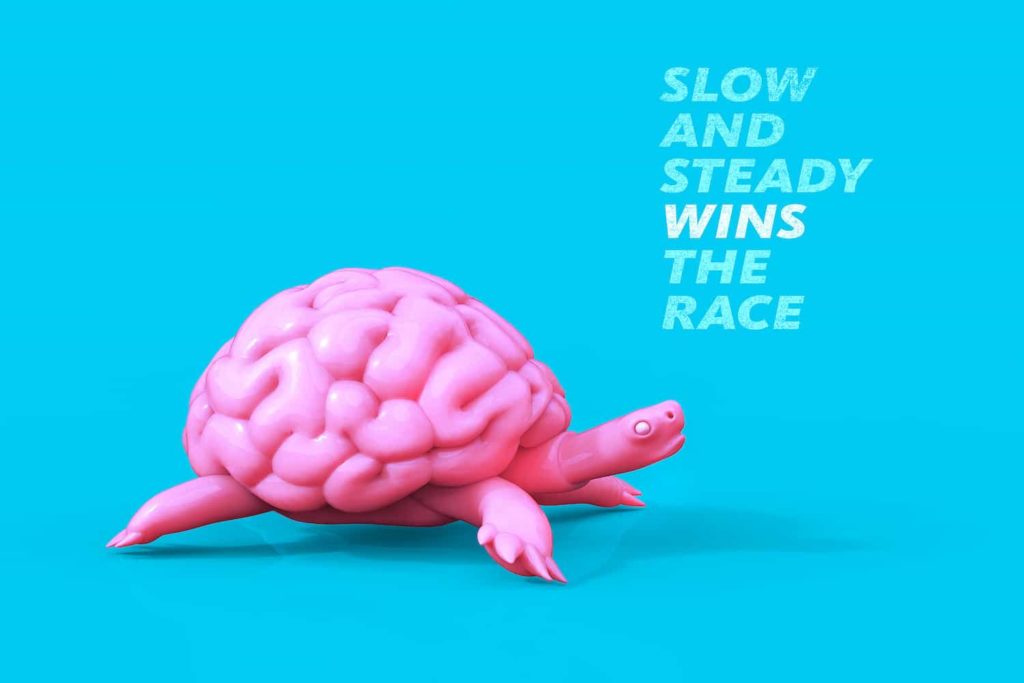
Daily Bits: A Plan for Sustainable Creativity
Many highly imaginative people hold Romantic ideas about creative work. They delight in the image of the artistic genius laboring manically for days at a time without eating or sleeping. At the completion of their masterpiece, they collapse in exhaustion and spend weeks if not months convalescing in the aftermath of their frenzy of inspiration.
Although few people live at this extreme, many creatives subscribe to milder versions of this tendency. Many of us are guilty of saying the following:
- “I can’t get anything done unless I have several hours of uninterrupted creative time.”
- “I need a deadline to complete a project in a big final push and I often pull all-nighters.”
- “I am so busy being productive that I am exhausted all the time” (said emphatically to prove my value).

Although these are treasured ways of thinking and working for many creative people, they are not, it turns out, sustainable ways of living. Beyond that, research shows that they are not actually very productive. This post presents an overview of a proven alternative: brief daily sessions for sustainable creative output.
Robert Boice, Faculty Writer
In my first year as a professor, I participated in a mentoring program for new faculty. The program gave us a book by Robert Boice with the straight-forward title of Advice for New Faculty Members (2000). I found the title dull, but the content a revelation. I contend that Boice’s research (from this and many other books and articles) hold lessons for creatives both within the academy and outside of it. A little about his background helps explain why.
Robert Boice is an emeritus professor of Psychology at the State University of New York at Stony Brook. His research examines the processes of writers, and particularly academic writers, using the tools of Psychology. The book is one of advice on how to work in happier and more productive ways, but it is not of the following type: “I did things this way, and it worked for me, so it will certainly work for you.” Rather, Boice analyzes the faculty experience through empirical research, conducting studies on faculty from differing types of colleges and universities. In other words, his advice is based on decades of scientific research.

But what does the work of professors have to do with creativity? Outside the world of academics, most people think of professors primarily as teachers. Teaching (which itself is a highly creative endeavor) is a big part of the job, but of equal importance (and even greater importance in some institutions) is the professor’s work of research and writing. Academics write for publication in research journals and books, for conference presentations, and for countless committee reports. In short, a large portion of the work of a professor is writing. And writing, of whatever kind, is a creative endeavor.
Beyond Academic Writing
Recently, a friend sent me excerpts from an earlier book by Robert Boice: How Writers Journey to Comfort and Fluency: A Psychological Adventure (1994). This book is about writing more generally, not just academic writing. Much of the reasoning and research, however, is similar to his advice for professors.
I think that Boice’s overarching ideas are applicable to creatives broadly defined, not just writers and academics, and so I summarize some of them for you here.
Brief Daily Sessions
One of Boice’s main points across his writing is that it is better to work in brief daily sessions rather than in long sittings that are more spread out. The benefits of this way of working are numerous.

One compelling justification for this technique is that if you work on your imaginative project every day (or at least most days), you are never far away from your last creativity session. There is none of the “start-up time” that is required when you have left a project go for a week or more. You can easily start up again the next day because you haven’t forgotten where you were. Most importantly, you haven’t lost your inspiration. In this way, brief daily sessions are a more efficient way of working.
The Devil’s Advocate
When I was reading Boice’s work for the first time, I often found myself doubting his advice based on my own experience of working franticly in long spurts just before deadlines. Just when I would feel this way, I would turn the page and read something akin to, “you may be thinking that brief daily sessions won’t work for you because you are the rare kind of person who actually needs long stretches of uninterrupted time and cramming before deadlines to get your work done. Well, we carried out a number of studies with groups of test subjects who believed that same thing and…”
You get the idea.
The point is not “trust Boice’s advice blindly.” Rather, question it and examine how the hypothesis has been tested repeatedly and the results confirmed.
Creative Binging and Burnout
One of the most convincing arguments for brief daily sessions revolves around sustainability. It is true that many people manage to get work done in long sessions (without adequate rest or nutrition) right before deadlines. What is often hidden in these scenarios is what happens afterward.

People who believe in the creative-as-martyr way of working don’t often consider the aftereffects of such techniques. Working in long, tiring bouts of creative frenzy or cramming before deadlines is unhealthy. Not only this, but most people who work this way experience big crashes afterward. Many go for long stretches of unproductivity following such creative binges.
More worrisome yet, working to exhaustion trains the body and mind to fear creative work. After time, people begin to dread their creative endeavors because they come to see them as a punishing. This way of working becomes its own deterrent from continued productivity.
Sustainable, Happy Work
The alternative to the unhealthy and ultimately unproductive binging on creativity is brief daily sessions, which I affectionately call daily bits.
Working in daily bits is a more humane and sustainable way of working, but also more productive. Robert Boice did the psychological studies to prove the point, but the idea has existed in folk wisdom for centuries.

We have all heard the aphorism, “slow and steady wins the race.” Even little children are familiar with the fable “The Tortoise and the Hare.” The wisdom of Aesop’s tale was recognized when it was composed nearly three thousand years ago, and the hundreds of ways it has been retold over the centuries proves its continued relevance.
And yet the Romantic image of the creative martyr and the fast pace of modern life have led us away from the wisdom of slow and steady, brief daily sessions, or daily bits. Perhaps you’ll be convinced of this wisdom, which is at once ancient and proven by modern Psychology. If so, I hope you’ll put it into practice in your own healthy, productive, and sustainable creative endeavors.